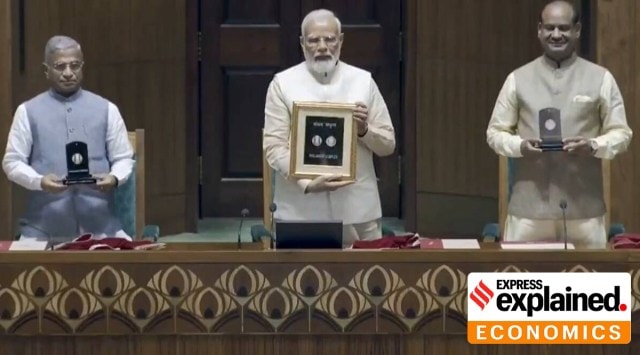PM Modi releases Rs 75 coin on new Parliament inauguration day: Features, how to get it
India has been issuing commemorative coins since the 1960s for several reasons such as paying homage to notable personalities, spreading awareness about government schemes, or remembering key historic events.
 Rajya Sabha Deputy Chairman Harivansh, Prime Minister Narendra Modi and Lok Sabha Speaker Om Birla releasing a commemorative coin of Rs 75 denomination to mark the inauguration of the new Parliament. (Photo: Twitter/@nsitharamanoffc)
Rajya Sabha Deputy Chairman Harivansh, Prime Minister Narendra Modi and Lok Sabha Speaker Om Birla releasing a commemorative coin of Rs 75 denomination to mark the inauguration of the new Parliament. (Photo: Twitter/@nsitharamanoffc)
To mark the inauguration of the new Parliament building, Prime Minister Narendra Modi released a commemorative coin of Rs 75 denomination on Sunday (May 28).
In a notification released on Thursday (May 25), the Ministry of Finance first announced the launch of the coin. “The coin of Seventy-Five Rupees denomination shall be coined at the Mint for issue under the authority of the Central Government on the occasion of the inauguration of the New Parliament Building,” it said.
India has been issuing commemorative coins since the 1960s for several reasons such as paying homage to notable personalities, spreading awareness about government schemes, or remembering key historic events.
What are the features of the new Rs 75 commemorative coin?
As per the Ministry of Finance notification, the latest Rs 75 coin is circular in shape with a diameter of 44mm. The composition of the coin is of a quaternary alloy — 50 per cent silver, 40 per cent copper, 5 per cent nickel and 5 per cent zinc.
“The face of the coin shall bear the Lion Capitol of Ashoka Pillar in the centre, with the legend “सत्यमेि जयते” (Satyameva Jayate) inscribed below, flanked on the left periphery with the word “भारत” (Bharat) in Devnagri script and on the right periphery the word “INDIA” in English,” the notification said.
It added that the other side of the coin displays an image of the new parliament building. The inscription “Sansad Sankul” is written in Devanagari script on the upper periphery while the words “Parliament Complex” in English on the lower periphery of the coin.
Hon’ble Prime Minister Shri @narendramodi releases the commemorative Rs 75 coin in the new Parliament during the inauguration ceremony. #MyParliamentMyPride pic.twitter.com/BpFmPTS5sT
— NSitharamanOffice (@nsitharamanoffc) May 28, 2023
How can one get commemorative coins and can we spend them?
If someone wants to acquire commemorative coins, they can do so by visiting the website of the Securities of Printing and Minting Corporation of India Limited (SPMCIL). Most often, such coins are meant to be just collectables as their worth may not necessarily be the same as their face value — they are partially made of precious metals such as silver or gold; as mentioned above, the latest commemorative coin is 50 per cent silver.
For instance, in 2018, the government issued a commemorative coin of Rs 100 denomination to honour former Prime Minister Atal Bihari Vajpayee but it’s currently available on SPMCIL’s website for ₹5,717. This coin is 50 per cent silver, and has other metals.
Who has the power to design and mint coins?
The Coinage Act, 2011 gives the central government the power to design and mint coins in various denominations. In the case of coins, the role of the RBI is limited to the distribution of coins that are supplied by the central government.
Speaking about commemorative coins, the central government regularly releases them according to its choice, but it also mints such coins at the request of third parties, according to a report by The Indian Express.
In 2017, the government issued commemorative coins to pay homage to Indian actor and politician Late MG Ramachandran and Carnatic singer MS Subbalakshmi. The decision was taken after “the request was placed by Sri Shanmukhananda Fine Arts & Sangeetha Sabha for the MS Subbalakshmi commemorative coins and by the Tamil Nadu government for the MG Ramachandran commemorative coins,” the report said.
All coins are minted in the four mints owned by the Government of India in Mumbai, Hyderabad, Kolkata and Noida.
When was the first time India issued a commemorative coin?
The country released its first commemorative coin in 1964 in honour of Jawaharlal Nehru, who had passed away that year.
- 01
- 02
- 03
- 04
- 05






































